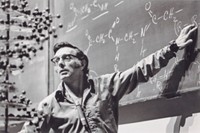Advertisement
Grab your lab coat. Let's get started
Welcome!
Welcome!
Create an account below to get 6 C&EN articles per month, receive newsletters and more - all free.
It seems this is your first time logging in online. Please enter the following information to continue.
As an ACS member you automatically get access to this site. All we need is few more details to create your reading experience.
Not you? Sign in with a different account.
Not you? Sign in with a different account.
ERROR 1
ERROR 1
ERROR 2
ERROR 2
ERROR 2
ERROR 2
ERROR 2
Password and Confirm password must match.
If you have an ACS member number, please enter it here so we can link this account to your membership. (optional)
ERROR 2
ACS values your privacy. By submitting your information, you are gaining access to C&EN and subscribing to our weekly newsletter. We use the information you provide to make your reading experience better, and we will never sell your data to third party members.
Environment
Seaborg’s Plutonium Roots
March 9, 2015
| A version of this story appeared in
Volume 93, Issue 10
As reported by Richard Strickert in his 2009 letter to the editor, the first sample of plutonium produced by Glenn Seaborg and his collaborators that was large enough to be weighed was on display for a number of years at the at University of California, Berkeley, Lawrence Hall of Science (C&EN, April 9, 2009, page 2). At some point in the late 2000s, as a result of both financial and perceived radiation safety concerns, the Lawrence Hall staff decided to remove this sample from display.
In 2008, a small plastic box with a label stating “First sample of Pu weighed 2.7 mg” was found at the Hazardous Material Facility on campus. It was assigned EH&S sample number S338. There it could have been discarded as radioactive waste were it not for the knowledgeable eye of Phil Broughton, a health physicist in UC Berkeley’s environmental health and safety department. The paper trail documenting this sample’s history had been lost, and so the question was what could be done to establish its authenticity as Seaborg’s plutonium?
In July 2014, Broughton delivered Sample S338 to our group in the nuclear engineering department at UC Berkeley. To preserve the possible historical significance of this object, it was decided that the box should not be opened and that only nondestructive testing should be done on it. As a result, we performed passive X- and gamma-ray analysis on the box. For photos of the box and details of our measurements, see: http://arxiv.org/abs/1412.7590.
Our studies showed that this object contained 239Pu and no other radioactive isotopes. The mass of 239Pu contained in this box was determined to be 2.0 + 0.3 mg. Although not 100% conclusive, these observations are consistent with the identification of this being the 2.77-mg PuO2 sample described by Seaborg and his collaborators as the first sample of 239Pu that was large enough to be weighed.
More detailed measurements such as mass spectrometry or chemical analysis could be performed, but that would require opening the plastic box and sacrificing some of the plutonium-containing material. It is hoped that in the near future a commemorative display will be set up in Seaborg’s office in Gilman Hall on the Berkeley campus where the discovery of plutonium was made. This object would be a fitting item to showcase in such a setting.
Eric B. Norman
Keenan J. Thomas
Kristina E. Telhami
Berkeley, Calif



Join the conversation
Contact the reporter
Submit a Letter to the Editor for publication
Engage with us on Twitter